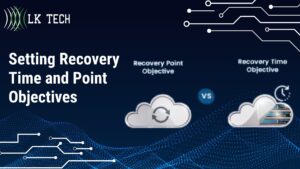The Importance of Setting Recovery Time and Recovery Point Objectives for Disaster Recovery
Disaster recovery planning is a critical activity for any business, but many small business owners don't know key metrics like RTO (recovery time objective) and RPO (recovery point objective). Understanding these recovery time and point objectives can make the difference between being back up and running in minutes versus days after a disaster strikes. Establishing realistic RTOs and RPOs requires careful analysis of your systems, processes and risks. With the help of an experienced IT services provider, you can optimize your disaster recovery strategy to minimize downtime and data loss.

- Setting Recovery Time and Point Objectives
What is RTO and Why Does it Matter?
RTO refers to the target time set for resuming operations after a disruption occurs. For example, you may set an RTO of 4 hours for critical systems like your e-commerce website. This means those systems would be restored within 4 hours following an outage or failure. The faster you can get back up and running, the less downtime your business will experience.
Some key factors that influence RTO include:
- The availability of backup systems and data recovery procedures
- The redundancies built into your infrastructure such as failover clustering or redundant internet connections
- How quickly replacement hardware can be acquired in the event of equipment failure
- Whether you have documented processes for restoring from backups
- If staff are trained on emergency procedures and can enact them quickly
A strong disaster recovery plan will enable RTOs of just minutes or hours, not days. Short RTOs help minimize revenue loss since your sales and operations suffer less disruption. They also minimize reputational damage since customers perceive you as being reliable and resilient if outages are resolved quickly. Lengthy downtime can cause customers to lose confidence and take their business elsewhere.
Setting appropriate RTOs requires analyzing each system and component of your infrastructure to determine:
- How mission critical the system/component is
- The impact to your business if it is unavailable for an extended period
- Steps for restoring functionality rapidly after a failure
More business critical systems warrant shorter RTOs. For example, your website may have an RTO of 1 hour, your customer database 4 hours, and your internal file server 24 hours.
The costs of achieving shorter RTOs have to be weighed against the potential lost revenue and other consequences of prolonged outages. Investing in high availability solutions like redundant servers and failover systems is often worth the upfront expense for core business systems.
What is RPO and Why Does it Matter?
RPO represents how much data you're willing to lose when restoring systems from backups. It's the maximum amount of data loss measured in time.
For instance, if you have hourly database backups, you have an RPO of 1 hour - meaning in a disaster scenario, you'd lose a maximum of 1 hour worth of new data that wasn't captured in the most recent backup. For a file server, you may only take daily backups, meaning an RPO of 24 hours and higher potential data loss.
The cost of more frequent backups has to be weighed against the business impact of potential data loss. Databases often require shorter RPOs than file servers. For databases that handle sensitive transactions, an RPO of just minutes may be needed.
Some factors to consider when determining RPOs include:
- The volume of data at risk if backups are less frequent
- The sensitivity/criticality of new data that could be lost
- The rate at which important data is updated
- The overhead to the system of taking more frequent backups
- The cost of storage to retain frequent backups
As with RTOs, higher priority systems warrant the expense of smaller RPOs. Backing up less critical data less frequently can save costs when appropriate.
Partnering With an IT Services Provider for Optimized Recovery Planning
Determining appropriate RTOs and RPOs requires in-depth knowledge of your systems, processes and risk factors. An experienced IT services provider can work closely with you to:
- Conduct a full assessment of your infrastructure and operations
- Identify potential risks like inadequate redundancies or single points of failure
- Evaluate existing backup plans and procedures
- Determine realistic RTOs and RPOs based on your budget and business requirements
- Map out enhancements to meet defined RTOs/RPOs such as adding redundancy
- Implement recommended actions like new backups or high availability systems
- Create detailed recovery plans with step-by-step procedures
- Continuously monitor and test systems to ensure recovery objectives are met
- Train staff on enacting the recovery plans for each system
- Update plans on an ongoing basis as infrastructure changes
A qualified provider brings experience from working with many clients in your industry. They know reasonable RTO and RPO targets and can develop cost-effective solutions tailored to your budget. With their guidance, you can create a recovery plan that keeps your business running even when disaster strikes.
Rather than leaving things to chance, proactively partnering with an IT services in Cincinnati, Ohio provider gives you peace of mind. You can feel confident you've taken the steps to minimize downtime and data loss. Contact us today to start optimizing your RTOs and RPOs with a customized recovery plan.


